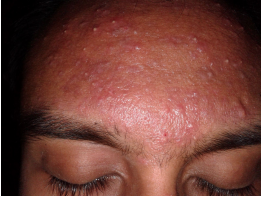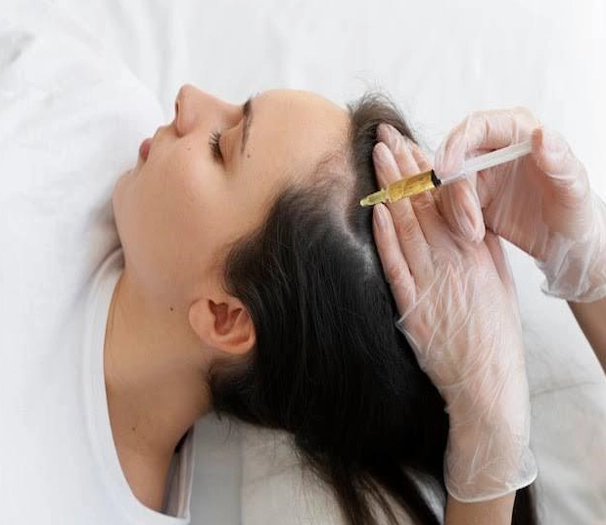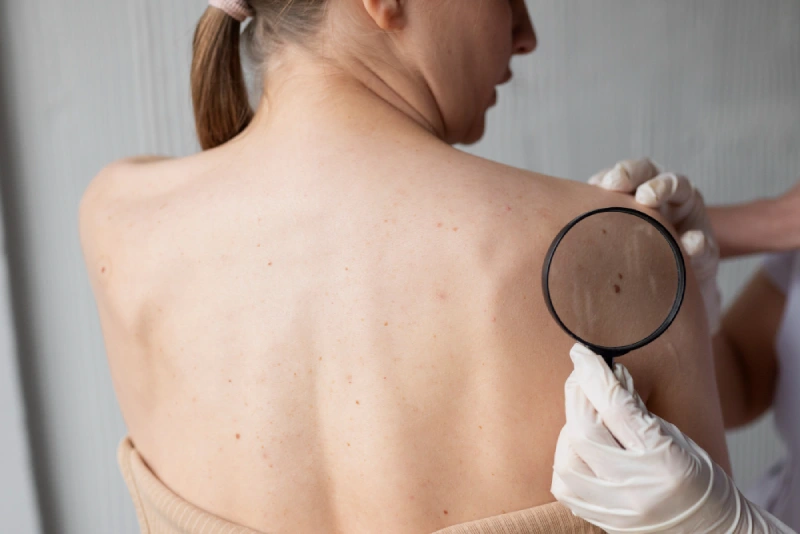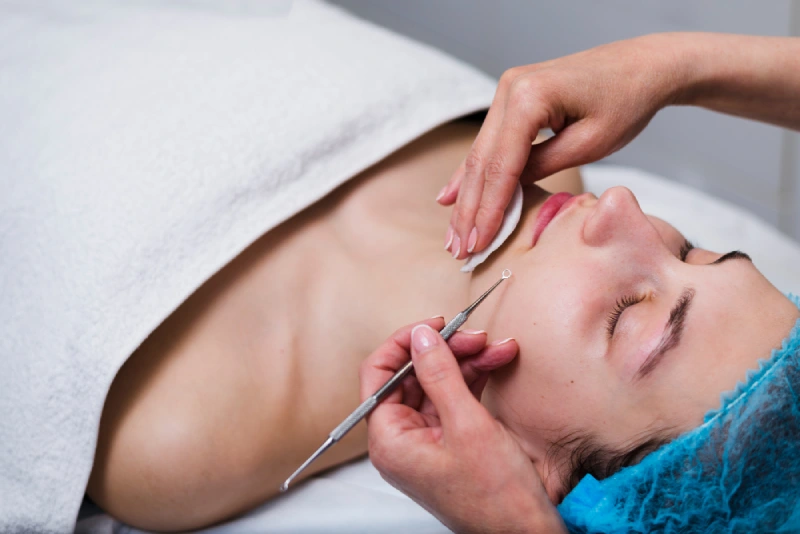According to the American Academy of Dermatology, about 40 to 50 million Americans have acne. Although most people think teenagers or young adults are who get acne, it can actually occur at any age, regardless of gender. Acne may not be life-threatening, but for some people it can be severe and disfiguring. People who have acne can also experience depression and low self-esteem.

Acne is caused by infection and inflammation of the hair follicle and sebaceous glands, or oil glands, in the skin. This is made worse by the shedding of dead skin cells, which plug up the hair follicle. Also, increased oil production in the skin makes the perfect breeding ground for acne-causing bacteria, Propionibacterium acnes. When the pores become plugged up with oil and bacteria, inflammation gets worse and causes a painful, red acne bump. Acne can appear on the face, neck, back, chest, shoulders and buttocks, and can leave red or brown marks or permanent scars.
Teenage acne occurs at puberty when androgen hormones increase and cause the skin’s oil glands to increase in size, producing more acne-causing oil. Normally, oil is supposed to keep our skin healthy and provide moisture, but when it’s over-produced, it can contribute to clogging pores and feeding the bacteria that causes acne, making acne worse. In women, androgens are released during pregnancy, around the time of your period, or with certain hormonal contraceptives like the birth control pill. Androgens can also contribute to oil production and worsen acne and dark marks. Bad hygiene habits, like waiting days to shower, not washing your face or picking at your acne with dirty hands can exacerbate acne and acne scars (resist the urge!). Even stress can trigger an acne breakout or make any active acne worse.
Acne blemishes are characterized into inflammatory and non-inflammatory. They include the following:
● Non-inflammatory acne:
○ Blackheads – pores filled with oil, dead skin cells and bacteria that react with oxygen and turn dark
○ Whiteheads – pores filled with oil and dead skin cells that are covered with layers of skin
● Inflammatory acne (more likely to scar):
○ Papules – red inflamed skin lesions that can be painful
○ Pustules – this type of blemish is your traditional “pimple” and is usually filled with pus that’s white or yellow
○ Cysts – pus-filled pimples found deep in the skin that are often painful and require medical attention
It is important to distinguish between these different types of acne blemishes because they are treated with different medications and some cause scarring more than others. If you have mainly inflamed acne lesions, it is important to see your dermatologist right away as early treatment could prevent these from turning into scars. You can find more information on scarring and treatment options here.
What is Holistic Dermatology?
Holistic dermatology relies on using all-natural products and remedies to treat skin conditions. Using natural dermatology to treat the underlying causes of an individual’s skin problem using the least invasive means first.
What Causes Your Skin to Break Out?
Although everyone has different underlying causes for skin issues these are some common things that can cause anyone’s skin to break out. Acne affects up to 80% of people sometime during their lives. So, it’s important to know what might be causing the breakouts so you can preemptively treat the root causes instead of focusing only on the symptoms.

Clogged Pores
The simplest cause of most breakouts are clogged pores for an assortment of reasons. Acne of all stages, white heads, black heads and pimples are all caused when your hair follicles become clogged with excess oil and dead skin cells. Often time in addition to regular daily activities, excess sweating, make-up use or a build-up of other products can affect negatively affect your pores.
Chronic Stress
One of the biggest factors when it comes to breakouts is hormonal changes. Hormones fluctuate for many different reasons and stress is one of them that affects both genders. Emotional stress hasn’t been proven to trigger brand new cases of acne, but it can prolong or worsen existing breakouts.
Inflammatory Reactions
Contrary to popular belief cutting out greasy foods alone has very little effect on acne. However, many studies have found links between worsened acne symptoms and dairy products, sugar, and carbohydrate-rich foods. It’s important to note that people’s bodies respond differently to all types of dietary restrictions, so it may not be a quick fix.
Tips and Tricks for Effective Holistic Dermatology
While many people are stuck at home unable to visit the dermatologist, the following suggestions are some holistic acne treatment tips that can be used at home.
Simple Stress Relievers
When cooped up at home, or under pressure from outside sources it’s important to take time for yourself and acknowledge the connection between a person’s mental health and their physical well-being. Practicing deep breathing or yoga, reducing your caffeine intake, exercising, lighting incense or candles and listening to music are all simple ways to reduce some stress that can have a positive effect on your skin.
Keep Clean
It may be common sense that you should establish a routine even when at home, but it can easy to forget. Avoiding touching your face is not only a good suggestion to avoid getting sick and spreading germs but it also keeps extra dirt and bacteria from transferring from your fingertips to your pores. While it is important to remove excess oil, buildup, and sweat washing your face too frequently or with harsh chemicals and exfoliants can have adverse effects as well. Use warm, water and a mild cleanser, do not scrub, rinse with cool water, pat dry with a clean towel and follow up with a moisturizer of your choice.
Switch Up Your Diet
While you may not have a severe allergy to certain foods or food groups if you are noticing worsening skin issues such as dryness, discoloration, itchiness and increased breakouts it’s worth it to examine your diet. Keep a food journal to help you keep track or try your own version of an elimination diet if you already suspect certain types of foods may be causing a break out. In general, decreasing your intake of processed food and sugar is a great first step. Increasing cruciferous vegetables such as broccoli, cauliflower, and brussels sprouts will help detoxify your system and fresh berries can help reduce inflammation.
Use Natural Products
There are some natural products that you may already have at home that can be used to relieve some symptoms. Dry bouts of inflammation like psoriasis or eczema can be soothed with ginger root, spirulina, and turmeric which are all-natural anti-inflammatory immune boosters. Oily skin and acne breakouts can be reduced with witch hazel and tea tree oil. Both of these can be used as a holistic treatment for acne because they address bacterial build up and help keep your skin clean and dry. Bakuchiol, a new and exciting holistic treatment has been shown to act like a natural retinoid, with less irritation. It can reduce acne and inflammation and prevent wrinkles.
Power Up with Probiotics & Supplements
Keeping your skin healthy from home can be as simple as boosting up your internal nutrients. A lot of nutrients come from our diet, however, sometimes supplements can help fill the gaps. Studies have linked increased intake of probiotics, omega-3’s, vitamin B, vitamin D, and zinc to benefiting people with acne. If you are unable to get these supplements, work on incorporating a nutrient-dense diet, make an effort to eat and drink things with higher levels of these key nutrients.
Consult with a holistic dermatologist online!
While non-emergency in-person appointments have been put on hold as a result of the COVID-19 pandemic, receiving a virtual consultation with a holistic skin care specialist to better understand your individual situation is highly recommended.




